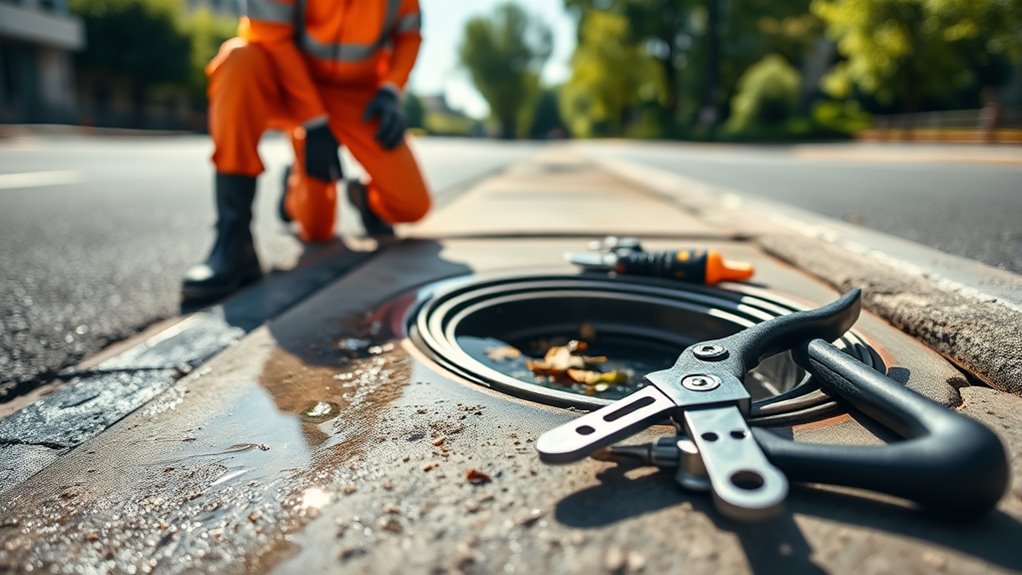To quickly maintain your catch basin in just 15 minutes, gather sturdy gloves, a scoop or trowel, and a hose or pressure washer. Locate the basin by finding ground grates in your landscape or near driveways, then clear away debris around the area. Remove the grate, clear out leaves, dirt, and sediment, and check for damage or blockages. Regular checks prevent backups and keep water flowing smoothly, and if you’re curious about more tips, keep going for expert advice.
Key Takeaways
- Gather necessary tools, safety gear, and prepare the area by locating catch basins and removing surrounding debris.
- Conduct a quick visual inspection to identify obvious blockages, damage, or sediment buildup.
- Remove surface debris and trapped leaves from the basin interior using a scoop or shovel.
- Clear the outlet pipe of obstructions and flush the basin with water to ensure proper drainage.
- Secure all covers and tools, verify the basin is clean and functional, then document the maintenance performed.
Gathering Your Tools and Supplies
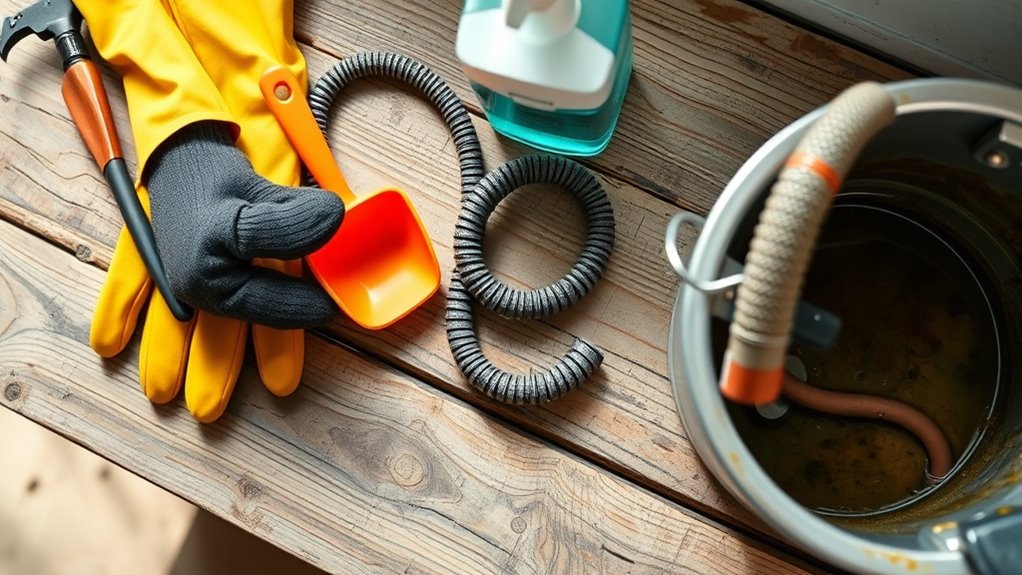
Before you begin cleaning the catch basin, it’s essential to gather all the necessary tools and supplies. Start with sturdy gloves to protect your hands from debris and grime. A bucket or container will help catch dirty water and debris as you scoop them out. Keep a garden trowel or scoop handy for removing leaves, dirt, and trash. A hose or pressure washer can help flush out remaining debris if available. You might also want a broom or brush for scrubbing the basin’s walls. Have rags or towels nearby for wiping surfaces. Finally, gather any safety gear like goggles or masks if you’re working in a particularly dirty or hazardous area. Having everything ready ensures your cleaning process is quick, efficient, and safe. Incorporating automation technologies can also help monitor and maintain catch basin systems more effectively over time.
Locating Your Catch Basins
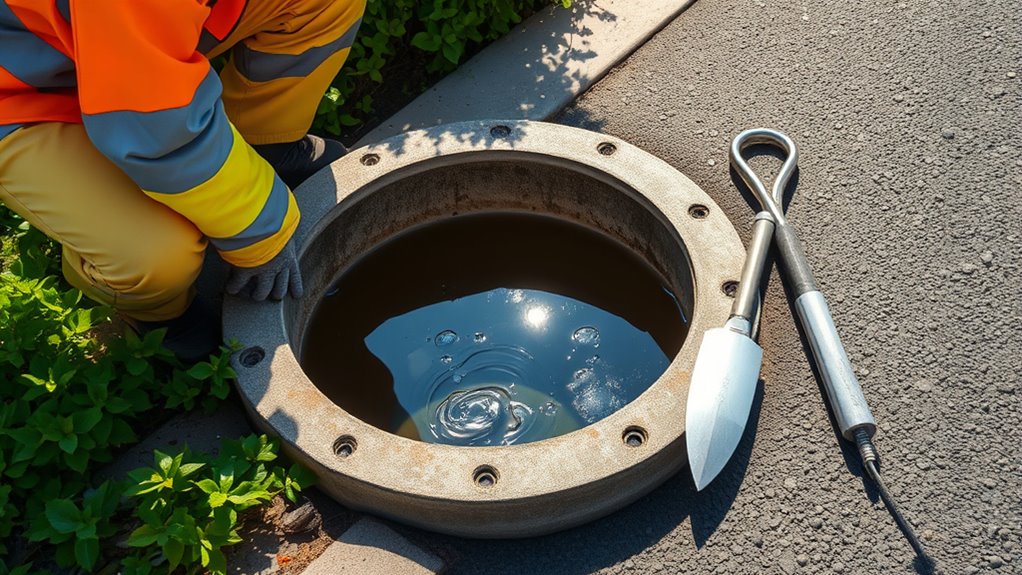
Where are your catch basins hiding? They’re often buried in plain sight, blending with your landscape or near driveways and sidewalks. Look for grates on the ground—usually square or round metal covers—placed in low spots prone to collecting water. Check along streets, parking lots, and near storm drains. Sometimes, they’re tucked behind bushes, trees,, or under landscaping features. Use your knowledge of your property’s layout to narrow down potential locations. If you’re unsure, follow visible water flow paths during rain or after watering the lawn; water tends to drain into these basins. Mark their locations if needed, so you can access them easily for regular maintenance. Knowing exactly where they are saves time and ensures you don’t miss any during cleaning. Additionally, understanding the location of catch basins helps in maintaining proper drainage and preventing water accumulation issues.
Preparing the Area for Cleaning
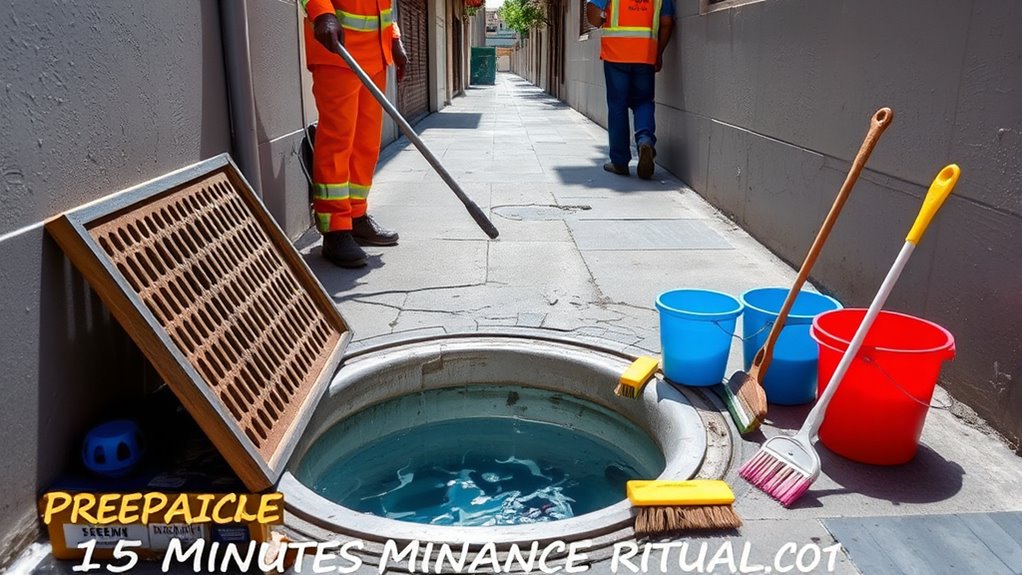
Before cleaning, remove any debris around the catch basin to prevent obstructions. Make sure nearby structures are secure to avoid accidents or damage. Taking these steps helps guarantee a safe and efficient cleaning process. Additionally, inspecting the surrounding water features can help identify potential issues that may impact the basin’s performance.
Clear Surrounding Debris
Have you ever wondered why clearing debris around a catch basin is essential before cleaning? It’s because loose leaves, trash, and dirt can block your access and hide potential issues. Removing this debris guarantees you can see the basin clearly and work more efficiently. It also prevents debris from falling inside once you lift the cover, which can make cleanup messier and harder. Use a sturdy broom or your hands (wearing gloves) to sweep away loose matter. Clearing the surrounding area reduces the risk of slipping or tripping during the process. Plus, it helps you identify any damage or clogs nearby that might need attention. Taking this simple step prepares you for a smoother, faster cleaning session and ensures your catch basin functions properly. Proper preparation can also minimize the chances of contamination of your water system during maintenance.
Secure Nearby Structures
To guarantee safety and prevent accidents during catch basin cleaning, it’s important to secure nearby structures and equipment. Loose objects or unstable fixtures can become hazards if dislodged during the process. Take a moment to assess the area and identify potential risks.
- Tie down or relocate loose tools and materials
- Use barriers or caution tape to block off the area
- Secure nearby fences or gates to prevent unauthorized access
- Stabilize any loose signage or equipment close by
- Ensure that nearby vehicles are parked away from the work zone
Removing the Grate or Cover
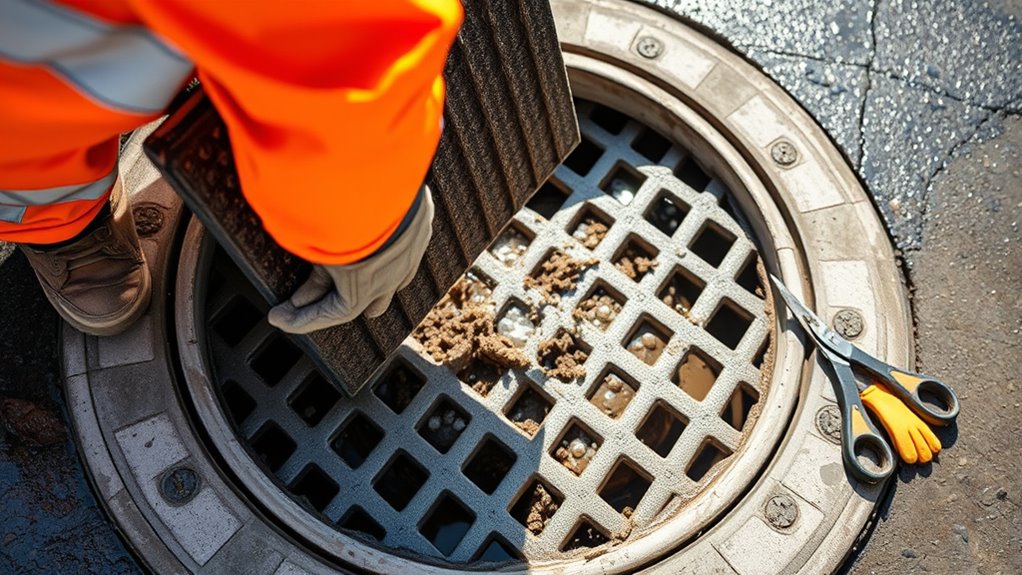
Wondering how to start removing the grate or cover from the catch basin? First, verify safety by wearing gloves and eye protection. Locate the edges of the grate; most are secured with clips, bolts, or latches. Use a flathead screwdriver or pry bar to gently lift or loosen these fasteners. If bolts are involved, use the appropriate wrench to unscrew them. Carefully lift the grate or cover straight up, keeping it stable to prevent it from falling or causing injury. Set it aside in a safe spot where it won’t be damaged. Take your time to avoid cracking or bending the cover. Proper projector maintenance ensures the cover remains in good condition and functions properly. With the cover removed, you’ll have clear access to the interior for cleaning.
Clearing Out Debris and Sediment

Once you’ve removed the cover, start clearing out debris and sediment that have accumulated inside the catch basin. Use your hands or a sturdy tool to scoop out leaves, dirt, and trash. Be thorough—small particles can clog the system later. Check the bottom for compacted sediment and loosen it with a shovel or scoop. Dispose of debris properly and avoid leaving messes around. Keep an eye out for any hidden obstructions or unusual buildup that might cause future problems. Wearing gloves protects your hands from sharp objects and contaminants. Regular cleaning prevents blockages and keeps water flowing smoothly. Remember, a clean catch basin helps prevent flooding and maintains proper drainage. Staying consistent with this routine also supports proper drainage systems and prevents costly repairs. Stay vigilant, and your basin will stay in top condition longer.
Inspecting for Blockages or Damage
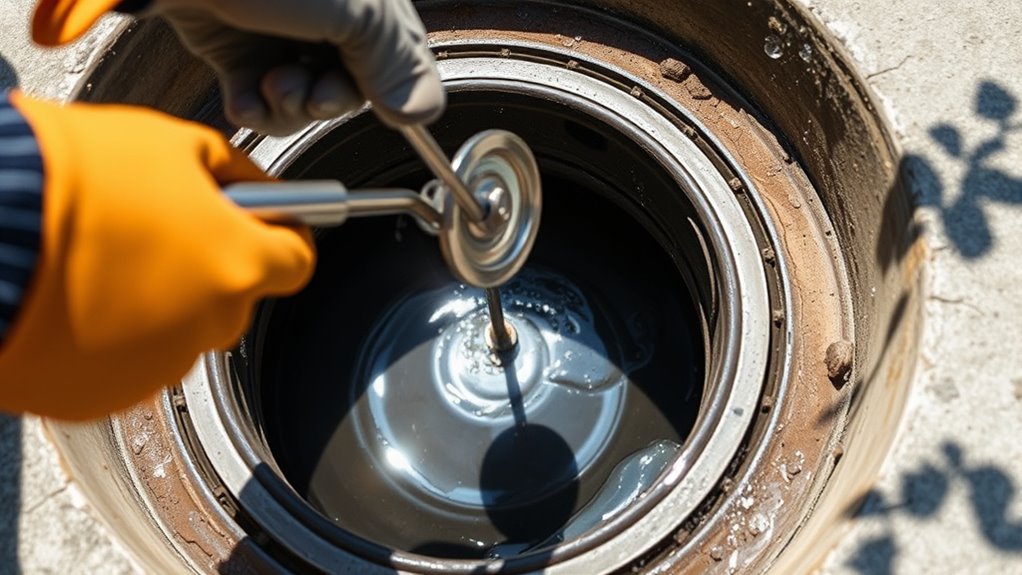
You should regularly perform visual checks to spot any blockages or signs of damage in the catch basin. Look for debris buildup, cracks, or displaced components that could hinder water flow. Addressing these issues early helps prevent flooding and costly repairs down the line. Incorporating preventative measures, such as using essential oils for maintenance, can also help support overall system health.
Visual Blockage Checks
Regularly performing visual blockage checks is essential to guarantee your catch basin functions properly. By inspecting it regularly, you can catch potential issues early and prevent costly repairs. Look for standing water, debris buildup, or signs of damage around the basin opening. Check for cracks, corrosion, or loose fittings that could compromise its effectiveness. Keep an eye out for any unusual odors or insects, which might indicate hidden blockages. Regular visual checks help maintain proper drainage and extend the lifespan of your catch basin. Monitoring filtration systems is also important to ensure debris and allergens are effectively captured, preventing obstructions.
Damage Signs Identification
How can you tell if your catch basin has suffered damage or is clogged? Start by inspecting the structure for cracks, rust, or broken parts—these signs indicate damage. Check the inlet and outlet pipes for blockages, debris, or corrosion that could restrict flow. Look inside the basin for excessive sediment, leaves, or trash buildup, which can lead to clogging. If water is pooling or draining slowly despite recent cleaning, it’s a sign of a blockage or damage. Also, listen for unusual noises when water flows through the system. Any cracks, displaced parts, or persistent backups mean you need to address damage or obstructions promptly. Regularly inspecting these signs helps maintain proper drainage and prevents costly repairs. Additionally, understanding the signs of system failure can help you catch issues early before they lead to more significant problems.
Flushing the Basin With Water

Have you ever wondered why flushing the catch basin with water is a crucial step in cleaning? This process helps remove loose debris, dirt, and residual grime that cleaning alone might miss. By running water through the basin, you push out stubborn particles and ensure the system stays clear. It also helps identify any hidden clogs or obstructions that could cause backups later. Plus, flushing promotes better water flow, preventing stagnation and foul odors. Fundamentally, it’s a simple yet effective way to complete your cleaning ritual and maintain proper drainage. Incorporating the use of simple tools like a quick‑calculators for water flow can further optimize this process.
Checking the Outlet Pipe for Clogs

Checking the outlet pipe for clogs is a vital step to guarantee proper drainage after cleaning the basin. First, locate the outlet pipe, which usually extends from the basin to the drainage system. Inspect it visually for any debris, dirt, or obstructions that might block water flow. Use a flashlight if needed to see inside the pipe more clearly. If you notice any buildup or blockage, gently remove it with a long brush or a plumbing snake. Avoid using harsh chemicals, as they can damage the pipe. Once you’ve cleared the clog, run water through the basin to confirm that it drains smoothly. Ensuring the outlet pipe is clear prevents backups and maintains efficient drainage in your catch basin.
Replacing the Grate or Cover Securely
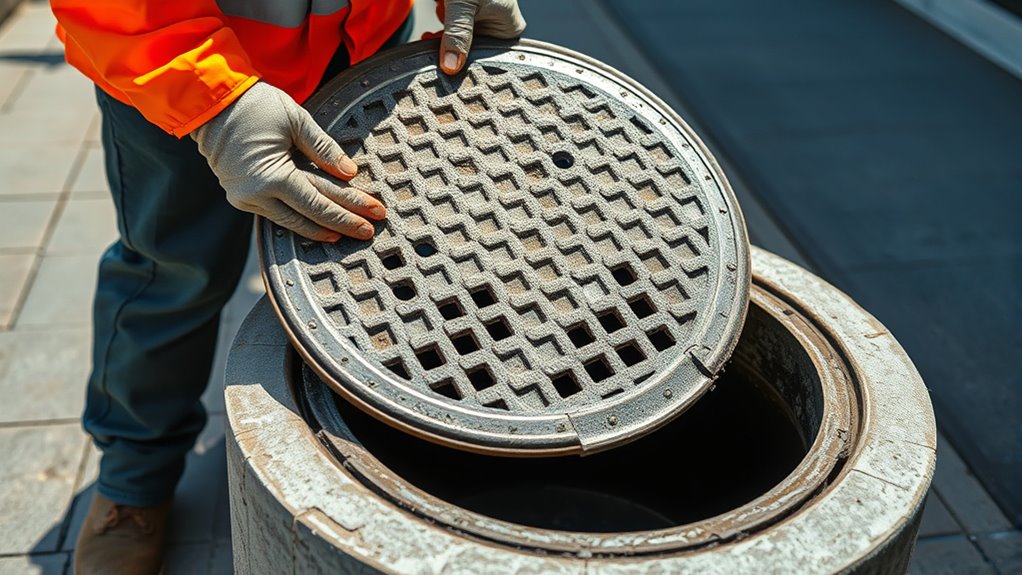
Make sure the grate or cover fits snugly to prevent debris from slipping through or causing hazards. Check that it’s properly aligned with the opening to ensure a secure fit. Taking these steps helps keep the catch basin functioning safely and effectively.
Secure Fit Verification
Ensuring the grate or cover fits securely is essential to prevent debris from entering the catch basin and to maintain safety. A proper fit keeps out trash and prevents accidental dislodging. To verify the fit, check that the grate sits flush with the surrounding surface and doesn’t wobble. Confirm there are no gaps or misalignments that could allow debris to slip through. Repeat this process after cleaning to ensure everything stays in place.
- Visually inspect for gaps or uneven edges
- Press down firmly to test stability
- Confirm the grate sits flush on all sides
- Look for any signs of damage or warping
- Test by gently stepping on the cover for stability
Proper Cover Alignment
To properly align the cover or grate when replacing it, start by carefully positioning it directly over the opening, making sure it sits evenly on all sides. Check that the edges are flush with the surrounding surface to prevent tripping hazards or debris getting underneath. Once aligned, press down firmly to ensure a secure fit. Confirm the cover is level and seated correctly before leaving the site. Use the table below to verify proper placement:
| Step | Action | Tip |
|---|---|---|
| 1 | Position cover over opening | Center it accurately |
| 2 | Check edges for evenness | Use your hand to feel for gaps |
| 3 | Press down firmly | Ensure it sits flush and secure |
Disposing of Debris Responsibly

Properly disposing of debris collected from catch basins is essential to protect the environment and prevent blockages. You want to make certain waste doesn’t end up in places it shouldn’t, which could harm local ecosystems or clog drainage systems. Always place debris in designated trash containers or recycling bins, depending on the materials. Never dump debris directly onto the ground or into storm drains. Consider composting organic matter when possible. Be aware of local regulations regarding waste disposal to avoid fines. Proper disposal minimizes environmental impact and keeps drainage systems functioning smoothly.
Proper debris disposal from catch basins protects ecosystems and ensures drainage systems stay clear.
- Use biodegradable bags for organic waste
- Separate trash from recyclable debris
- Avoid mixing hazardous materials
- Follow local disposal guidelines
- Schedule regular disposal pickups
Documenting the Maintenance Process
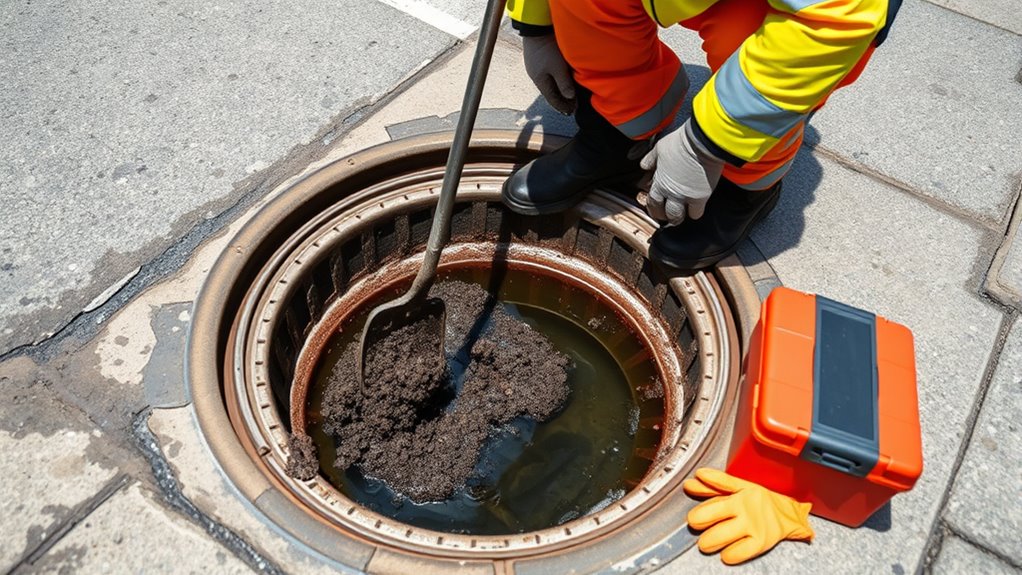
To guarantee your maintenance is well-documented, focus on clear visual inspection techniques that accurately record the basin’s condition. Keep detailed records of each inspection to track changes over time and identify recurring issues. Implementing consistent recordkeeping practices helps verify maintenance tasks and supports future planning efforts.
Visual Inspection Techniques
Conducting thorough visual inspections is essential for documenting the condition of catch basins during maintenance. Your goal is to identify issues early and ensure proper functioning. Use a flashlight to check for sediment buildup, debris, or standing water. Look for cracks, corrosion, or damaged components that may need repair. Note the presence of weeds or obstructions blocking inflow or outflow pipes. Observe the condition of the grate—any rust or damage could compromise safety. Keep an eye out for signs of erosion or sediment accumulation around the basin edges. Regularly recording these observations helps track deterioration over time and guides maintenance priorities.
- Check for debris and sediment levels
- Inspect for cracks or corrosion
- Assess grate integrity
- Observe flow obstructions
- Document any structural damage
Recordkeeping Best Practices
Accurate recordkeeping is essential for tracking the condition and maintenance history of catch basins. When you document each cleaning, inspection, and repair, you create a clear history that helps identify recurring issues and prioritize future work. Use a standardized form or digital system to log key details such as date, location, debris removed, and any repairs performed. Include photographs and notes on unusual findings or damage. Regularly review these records to spot patterns or deterioration signs early. Consistent documentation guarantees accountability, improves planning, and supports compliance with local regulations. Keep records organized and easily accessible, whether digitally or physically. Well-maintained logs make future maintenance more efficient and help extend the lifespan of your catch basins.
Scheduling Regular Catch Basin Checks
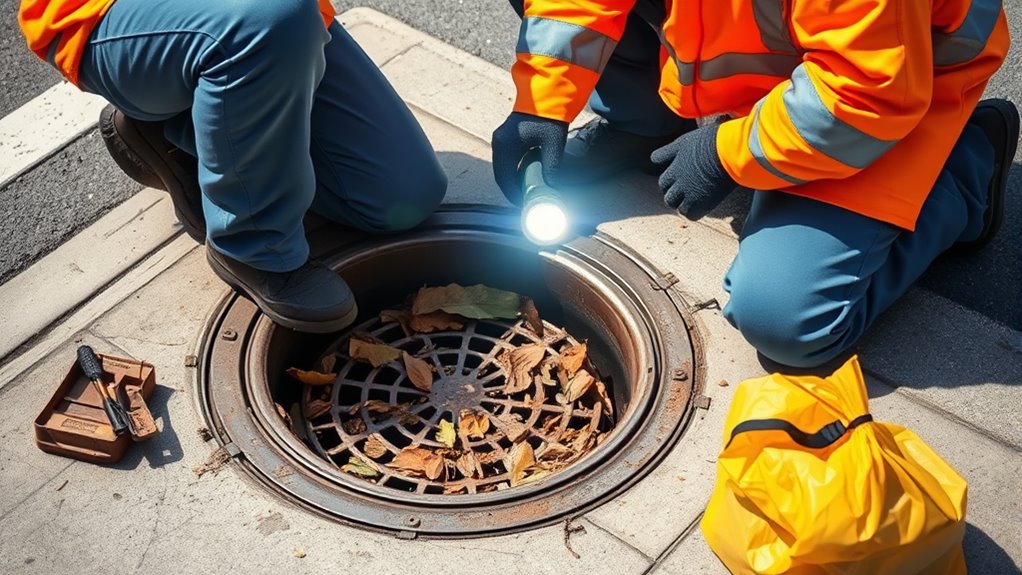
How often should you schedule catch basin checks to keep your drainage system functioning properly? Regular inspections prevent blockages, reduce flooding risks, and extend the lifespan of your drainage system. Generally, you should check your catch basins:
- Monthly during heavy rain seasons to catch debris early
- Quarterly in dry periods to remove accumulated dirt
- After storms or severe weather events to clear any debris brought in
- Before winter to prevent ice blockages
- Annually for a all-encompassing inspection and maintenance
Sticking to this schedule helps you stay ahead of potential problems, saving time and money in the long run. Consistent checks ensure your drainage system works efficiently when you need it most.
Tips for Preventing Future Clogs

Implementing simple preventive measures can substantially reduce the chances of future catch basin clogs. Regularly remove debris like leaves, trash, and dirt from the surface before it enters the basin. Consider installing a grate or filter to catch larger debris and make cleaning easier. Avoid dumping grease, oils, or chemicals nearby, as these can cause blockages or harm the drainage system. Keep nearby landscaping well-maintained to prevent excessive soil erosion or plant debris from washing in. Educate your team or family about proper waste disposal to reduce littering around the area. Routine inspections, even if no problems are apparent, help catch potential issues early. These small steps can save you time, money, and prevent flooding caused by clogged catch basins.
Recognizing When Professional Help Is Needed
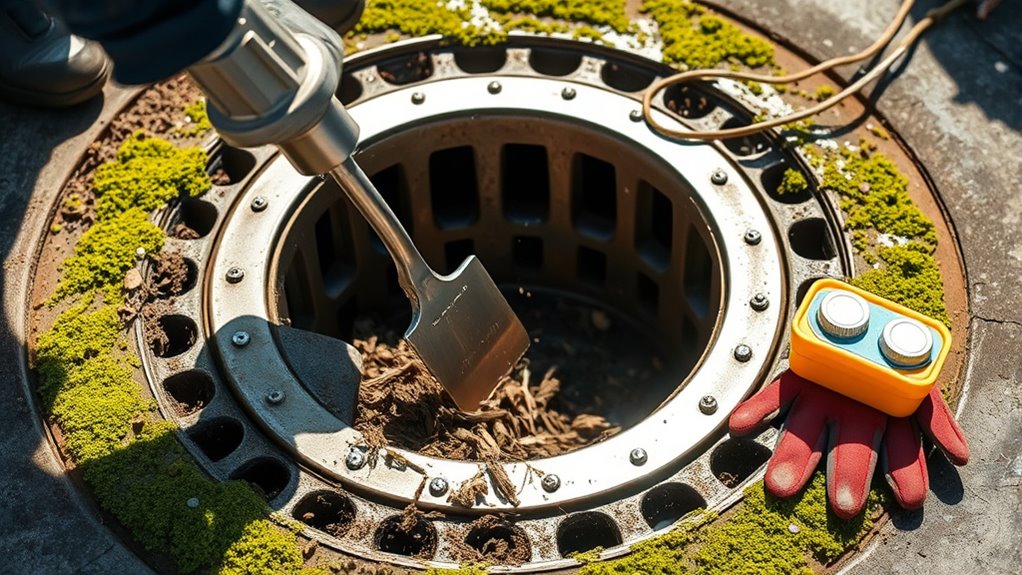
Knowing when to call in a professional is essential to maintaining an effective and reliable drainage system. If you notice persistent problems or signs of trouble, it’s time to seek expert help. Watch for these warning signs:
Knowing when to call a professional ensures your drainage system stays reliable and trouble-free.
- Severe or persistent flooding around the catch basin
- Unpleasant odors that won’t go away
- Water draining very slowly or not at all
- Visible debris or sediment buildup that won’t clear with simple cleaning
- Unusual sounds like gurgling or bubbling during rain or flushing
Ignoring these issues can lead to costly damage or backups. Professionals have the tools and expertise to diagnose underlying problems and ensure your drainage system functions properly, saving you time and money in the long run.
Final Inspection and Cleanup
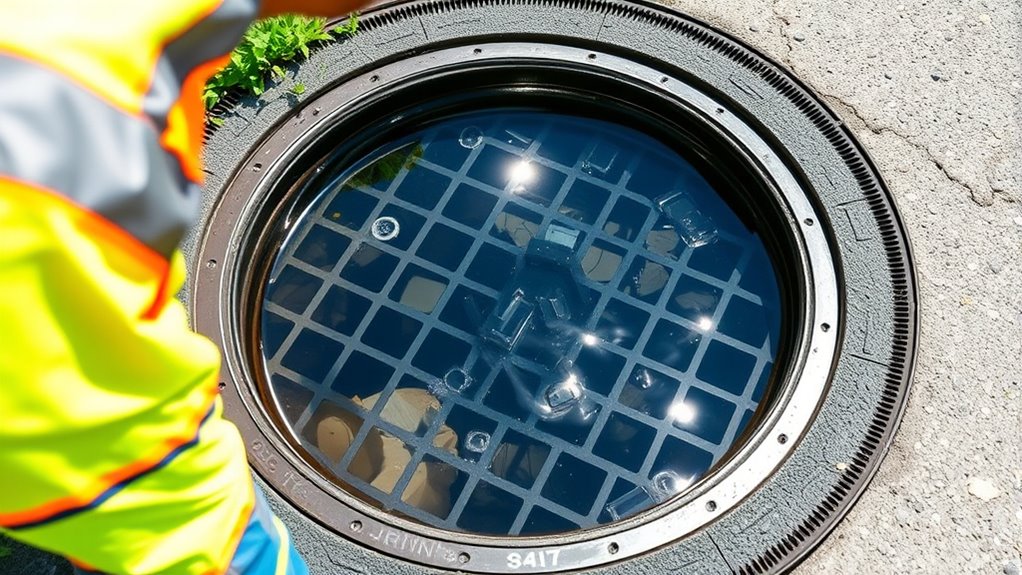
After completing the cleaning process, it’s important to conduct a thorough final inspection to guarantee your catch basin is functioning correctly. Check for any remaining debris or blockages that could impede water flow. Ensure the grate is securely in place and undamaged. Look inside the basin for signs of sediment buildup or trapped debris, removing anything that could cause future clogs. Verify that the outlet pipe is clear and unobstructed. Once you’re satisfied with the condition of the basin, clean the surrounding area, removing any debris or tools used during maintenance. This final step guarantees your catch basin is ready to perform at its best and helps prevent future issues. A quick inspection and cleanup now save you potential trouble later.
Frequently Asked Questions
How Often Should Catch Basins Be Cleaned Beyond the 15-Minute Routine?
You should clean your catch basins more thoroughly every 6 to 12 months, depending on local conditions like rainfall and debris buildup. Regular inspections help identify when a deeper cleaning is needed beyond the quick routine. If you notice slow drainage or standing water, it’s time for a more intensive clean. Consistent maintenance guarantees your system functions properly, preventing backups and costly repairs.
What Safety Precautions Should I Take During Catch Basin Cleaning?
Think of catch basin cleaning like tending a garden—you need gloves, proper tools, and awareness of your surroundings. Always wear protective gear, including gloves and safety goggles, to avoid contact with hazardous waste. Confirm the area is well-ventilated and use caution with tools. Follow OSHA guidelines, and never work alone if hazards exist. Staying vigilant keeps you safe, just like a gardener safeguarding their plants from harm.
Can I Use Household Chemicals to Clear Clogs in Catch Basins?
You shouldn’t use household chemicals to clear clogs in catch basins. These chemicals can damage the basin’s materials and harm the environment. Instead, use proper tools like a drain snake or a high-pressure water jet designed for catch basin cleaning. If the clog persists, it’s best to contact a professional. This approach keeps you safe and ensures the job gets done effectively without causing environmental harm.
Are There Signs Indicating a Catch Basin Requires Professional Inspection?
Yes, you should seek professional inspection if you notice persistent flooding, foul odors, or slow drainage from the catch basin. If debris or blockages aren’t cleared after simple cleaning, or if you see structural damage or rust, it’s time to call in experts. Addressing these signs promptly prevents backups and water damage, ensuring your drainage system functions properly. Regular inspections help catch issues early and maintain your catch basin’s efficiency.
How Does Weather Affect the Frequency of Catch Basin Maintenance?
Weather greatly influences how often you should clean your catch basin. Heavy rain or snowmelt can quickly fill it with debris and water, demanding more frequent maintenance to prevent flooding. Conversely, dry periods reduce debris buildup, allowing longer intervals between cleanings. You need to stay vigilant during storms, inspecting and clearing your basin promptly to protect your property. Weather’s unpredictable nature means consistent monitoring is essential for effective catch basin upkeep.
Conclusion
By dedicating just 15 minutes to catch basin cleaning, you transform a mundane task into a shield against flooding and property damage. Think of it as your silent guardian, standing watch beneath the surface, preventing chaos before it starts. Regular maintenance isn’t just a chore; it’s an investment in peace of mind, ensuring your drainage system remains a steadfast protector. Embrace this ritual, and let your proactive care speak volumes in safeguarding your home.
